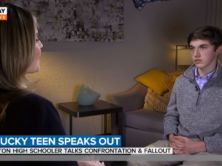(Credit: Cape Cod Times, screenshot)
After finding out one its longtime reporters, Karen Jeffrey, had used fake sources in at least 34 of her stories, the Cape Cod Times came clean and apologized to readers on Dec. 4.
In an explanatory note published on the Times site, Cape Cod Times’ publisher Peter Meyer and editor Paul Pronovost commented they are “heartbroken” by having “broken that trust” with readers because Jeffrey, a Cape Cod Times reporter for 31 years, had “admitted to fabricating” and making up names for sources and now “no longer works for the Cape Cod Times.” The Cape Cod Times is a daily Massachusetts newspaper with a circulation of about 36,000 copies.
When iMediaEthics contacted the Times for more information about its reaction to this journalistic failing, Pronovost explained that in light of Jeffrey’s fabrication and this “painful lesson,” staff are “strongly committed to rebuilding the trust we broke” and “earn our readers’ confidence” back.
Meyer and Pronovost’s report offered an inside view of their feelings and actions over this betrayal of trust and openly gave readers information including how the paper discovered the fabrication, how it reviewed the reporter’s work, what it will do with the problem content and how it will move forward to prevent similar problems.
Further, Pronovost wrote by email that Jeffrey’s fabrication “heightens our awareness of how badly our credibility can be damaged by anything less than the highest ethical standards by 100 percent of the people.” While the paper is “still digesting and soul-searching in the wake of this incident,” Pronovost laid out some of the ways the Times is planning to move forward.
Some changes the newspaper will make include spot checking reporters’ work, updating formal practices and holding more training for its staff, including ethics training for new hires, he added.
The Times also has “reactivated” its Accuracy and Credibility Committee to ensure the Times “policies and practices” — including its “accuracy checklists” — are current. The loftily-named committee, comprised of “newsroom staff,” will update its 2006 book of the newspaper’s “internal style guide, public record laws,” “newsroom policies and practices” and more, including incorporating social media more fully into the handbook.
“Beginning next week, they will meet monthly in the larger group, with subcommittee meetings more frequently,” Pronovost said in a follow-up email. “They have been told to plan about five hours per month to this effort (plus or minus, depending on the particular task at hand).”
One avenue for the Times‘ forthcoming formal training may be having “veterans of similar incidents” come in and explain how to handle the situation and “to prevent future problems.” In an email about the reaction to the incident and future training at the newspaper, Pronovost wrote:
“I’ve been overwhelmed by the positive response today from journalists pleased with how we handled this situation openly, quickly and thoroughly; they have offered to continue a dialogue and I’m hoping that can lead to some staff training.”
In a follow-up email, Pronovost explained the newspaper holds “numerous training sessions” each year on topics that “range from issues such as libel to the use of social media in our jobs,” but the Times is still planning a “specific program about journalism ethics” and violations (the date of the program is still to be decided). He added that since the Times’ fabrication has been publicized this week, he’s received “a large response from all walks of life” including journalists, many of whom offered “stories of their own experiences with ethics violations.” Pronovost added that the Accuracy and Credibility Committee will work with him on setting up “the ethics training session(s) and the orientation session for new employees and interns.”
The Times will also “significantly expand” who at the newspaper can use the papers “good search databases” so that “more people, from copy editors to features editors” can participate in “broader source-checking.”
According to the Times‘ note on its website, it found out about the fabrication issue last month “when a Veterans Day assignment raised questions among editors, who decided to closely review the story Jeffrey wrote.” Jeffrey apparently made up the Chipman family, who she featured in the opening of her story. As the Times’ note explained, it couldn’t “find the Chipman family” and “Jeffrey said she could not because she threw away her notes.”
The Cape Cod Times detailed its review, noting that at first it focused on the past 15 months where there were six stories featuring questionable sourcing. But the Times continued to check her work:
“An expanded review of Jeffrey’s work uncovered dozens of additional stories with suspect sources. We spot-checked work prior to 1998, when we relied on paper clips for archives, but have not found any questionable sourcing. We do not have a full archive of each reporter’s clips prior to 1998.”
“Many stories written by Jeffrey” were sound from a sourcing perspective, according to the Times, which characterized the problematically sourced stories as “typically lighter fare.” Further, the Times noted it expanded its review to look at “several other reporters’ work” to make sure that “this situation was isolated to Jeffrey.”
The Times said it is unpublishing the “questionable stories or passages of stories” and putting up “a note that explains why it was removed.” Cape Cod Times’ Asst. Managing Editor Digital Media Anne Brennan told iMediaEthics by email that the Times’ “corporate tech support folks are still working on deleting the stories and replacing them with a message, but we have put a note to our readers at the bottom of stories in which we deleted materials found to be fabricated by Karen.” As an example, Brennan pointed to this Aug. 16, 2010 article, which carries the following note:
“Note to Readers: A passage in the original version of this article was removed on Dec. 6, 2012, because it contained quotes attributed to a person who could not be independently verified. The quotes were contributed by reporter Karen Jeffrey, who as of Dec.4, 2012, was no longer employed by the Cape Cod Times.”
Brennan added that the plan is to put a similar note as the one following when stories are totally unpublished :
“Note to Readers: ‘Superstorm set to wallop Cape today,’ written by reporter Karen Jeffrey and published online on Oct. 29, 2012, was removed from the Cape Cod Times websites on Dec. 6, 2012. Three people quoted in the article about preparations on Cape Cod for Hurricane Sandy could not be verified. The people named in the article could not be found during a database search so the quotes could not be independently verified. As of Dec. 4, 2012, Jeffrey was no longer employed by the Cape Cod Times.”
One of the new measures the Times will take because of this incident includes spot checking reporters every week. Pronovost told iMediaEthics by email:
“We have verified reporting sources, but now will put a process in place to check them consistently, using a combination of public-record searches and actual phone calls to sources. Three reporters will be chosen at random to have their work checked weekly. We are currently working out the details of how the process will work.”
Interestingly, the news of Jeffrey’s firing even made it to the French newspaper Le Figaro.
iMediaEthics has written numerous times — this year alone — about news outlets admitting to issues related to fabrication or plagiarism but not offering much more in terms of details. iMediaEthics appreciated that when we contacted the Times, they were transparent and gave us information about what the newspaper is doing to move past this. Similarly, Poynter‘s Craig Silverman highlighted “Four Things the Cape Cod Times did right” in its report on Jeffrey’s fabrication.
“This is the first time we’ve ever faced a situation like this, certainly in my time here (since 2000) and probably in the 75-year history of the paper. I want it to be the last,” Pronovost noted to iMediaEthics by email. “We felt strongly that the first step to rebuilding our trust with the community was to be transparent with what happened and treat ourselves as we would any other story subject. Anything short of that would have failed our journalistic mission and made a bad situation even worse.”
Hat Tip: Jim Romenesko via Media Bistro Morning Newsletter






